 www.U-35.com
www.U-35.comThe Homepage for U-35, a Type VII U-Boat
... 1936 - 1939 ...
|
|
|
|
|
|
|
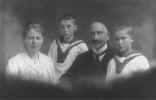 The
Stamer family in April 1921. From right: Gerhard Stamer, his father Heinrich
Stamer, his brother Hans-Heinrich Stamer, and his stepmother Lore
Stamer. His mother, born Auguste Caspari, died in 1919.
The
Stamer family in April 1921. From right: Gerhard Stamer, his father Heinrich
Stamer, his brother Hans-Heinrich Stamer, and his stepmother Lore
Stamer. His mother, born Auguste Caspari, died in 1919.
Gerhard Stamer joined the Reichsmarine (German
Navy, which was later renamed Kriegsmarine) on 01 April 1932 (Crew 32).
Because he was on the engineering officer track, he was not on board the training
ship Niobe when it sank on 26 July 1932 with the loss of 69 men,
including 27 officer recruits.
He became a Kadett (Ing.) (Engineering Cadet) on 04 Nov 1932. He served on board the Kreuzer (cruiser) Köln from 06 November 1932 to 02 January 1934.
He was promoted to Fähnrich (Ing.) on 01 January 1934.
He joined the crew of the Kreuzer
Königsberg on 22 May 1935, and was promoted to Oberfähnrich (Ing.) on 01 September 1935. On 01 January 1936 he attained the rank of Leutnant (Ing.) (Junior Lieutenant, Engineer), second among the class of 22 Engineering Officers.
 Leutnant (Ing.) Gerhard Stamer in August 1936. Leutnant (Ing.) Gerhard Stamer in August 1936.
|
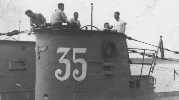 unknown,
unknown, Willi Dietrich, unknown, and Gerhard Stamer (right) on the conning tower of
U-35 in August 1939. [56] unknown,
unknown, Willi Dietrich, unknown, and Gerhard Stamer (right) on the conning tower of
U-35 in August 1939. [56]
|
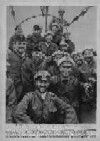  The crew of U-35, including Gerhard Stamer, upon return from the first war patrol. [33,cover photo of 32]
The crew of U-35, including Gerhard Stamer, upon return from the first war patrol. [33,cover photo of 32]
|
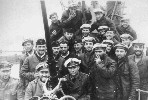  Another photograph taken of the U-35 crew, including Gerhard Stamer, upon return from the first war cruise. [35]
Another photograph taken of the U-35 crew, including Gerhard Stamer, upon return from the first war cruise. [35]
|
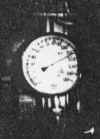 On
12 October 1939, he and Theodor Schütt were awarded Iron Crosses
(second class) for making successful repairs to U-35 on 21 September 1939 while sitting at the bottom of the sea at 115
meters (377
feet). A British destroyer had dropped only one depth charge (because, said the
escort captain, contact was doubtful). That depth charge was so accurately
placed that it knocked out one of U-35's periscopes and put the blower
system out of action. On
12 October 1939, he and Theodor Schütt were awarded Iron Crosses
(second class) for making successful repairs to U-35 on 21 September 1939 while sitting at the bottom of the sea at 115
meters (377
feet). A British destroyer had dropped only one depth charge (because, said the
escort captain, contact was doubtful). That depth charge was so accurately
placed that it knocked out one of U-35's periscopes and put the blower
system out of action.
|
He was promoted to Kapitänleutnant (Ing.) (Lieutenant Commander, Engineer) on 01 November 1939 (24th in the class of 27).
29 November 1939; from the reminiscences of Gerhard Stamer [39]:
Dawn. "Enemy Destroyers in sight!" "Alarm" "Dive" "Go to 13 metres (42 feet)". That is how it started.
During the attempt to attack the Home Fleet somehow, if it should leave harbour to intervene in the return home of our battleships SCHARNHORST and GNEISENAU we were picked up by the sonar sets of three British Destroyers, KINGSTON, KASHMIR and ICARUS approximately 60° North 2° East. Depth charge attacks lasted until noon. There were no direct hits but leaks developed which made it increasingly difficult to hold the boat down and when the last salvo jammed the hydroplanes in the "Hard Up" position the boat could no longer be held and the attempt to force the boat back below the surface through quick flooding of the ballast tanks failed as a main vent jammed.
"All hands abandon ship". Later as the last person below deck I succeeded in clearing the jam and as I reached the bridge the boat sank beneath the Captain's feet and mine.
We drifted for some hours in our life jackets until the British Destroyers turned towards us again and threw ropes to us with which we were landed on board.
Our treatment was excellent, just like ship-wrecked people. It was the destroyer H.M.S. KASHMIR who took most of the crew, with me as the Senior Officer; the rest, with our Captain, were picked up by H.M.S.KINGSTON. All were saved including our two non-swimmers.
On board we learned that the Chief of their Destroyer Flotilla was Lord Mountbatten, cousin of the King.
At my request we were allowed to speak with our men. Lieutenant Commander Scatchard gave up his cabin to
me.
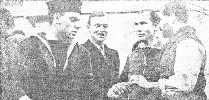 On board HMS Kashmir: a british sailor, Heinz Erchen, Gerhard Stamer, and Georg Ludwig Hengen. [60]
On board HMS Kashmir: a british sailor, Heinz Erchen, Gerhard Stamer, and Georg Ludwig Hengen. [60]
|
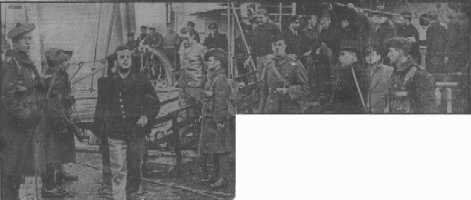 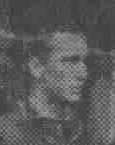 Part of the crew of U-35 departing HMS KASHMIR. Recognizable: Paul Liebau, Fritz Pietsch, Gustav Horstkötter, and Gerhard Stamer. [60,75]
Part of the crew of U-35 departing HMS KASHMIR. Recognizable: Paul Liebau, Fritz Pietsch, Gustav Horstkötter, and Gerhard Stamer. [60,75]
|
Before we were turned over to the Army in Birkenhead he told me to sign the Visitors' Book. To my reply "There is a war on you know" he said "That has nothing to do with it. The first name in this Visitors' Book is that of our Chief's cousin, His Majesty the King. You are the second". I could never get over this.
The difference between our treatment on board and on land we then found great. We were transferred to London and put up at The Tower. We were not very happy with our treatment. That became sensationally better after a visit announced to us by the Sergeant "The Cousin of the King comes!"
Prisoners of War being paraded on arrival in Gravenhurst, Ontario, Canada: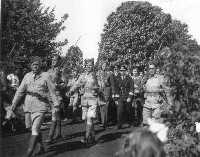 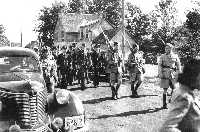
|
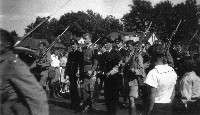 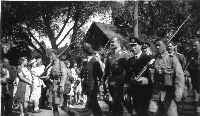
|
One day at Kingston, Ontario (Fort Henry, POW camp 31), Gerhard Stamer and others were occupied on the toilet seats when General Major Georg Friemel (the senior German officer in the camp) entered the room to go to the bathroom. Gerhard Stamer remembers:
We lifted a little bit and I said "Gentlemen, the General", and he said, "Please, Stamer, forget the nonsense." We all laughed heartily.
In the fall of 1940, one of the casemates was transformed into a beer cellar, named "Heldenkeller" (Heroes Cellar), thanks to the efforts of Gerhard Stamer and three other men. A mural is still there today gracing the ceiling of the casemate beer cellar. There are three scenes: one is of a knight and a monk to signify courage and wisdom, drinking together; another has two knights in combat to signify the ideology of fighting to the end; the third shows an attack on a merchant convoy. Crests were painted under the murals to represent German squadrons, towns, and families. [16,24]
In July 1941, evidence of one of the many escape attempts was found in the dining hut. Gerhard Stamer was sentenced to twenty-one days detention and assessed the cost of the damages to the canteen wall. But the next day when two other officers admitted to the 'crime', Gerhard Stamer was released. [16]
Some of the officers were later moved back to the Gravenhurst, Ontario POW camp. Luftwaffe pilot Ulrich
Steinhilper remembers Gerhard Stamer there, and includes this group photograph in his memoirs [29]:
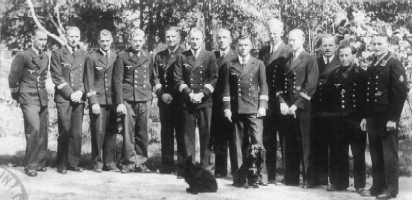 In the Gravenhurst POW camp, from left: Gerhard Stamer (U-35), Heinz Erchen (U-35),
Hermann Beckmann (U-27), Albert Schrader (U-35), Werner Lott (U-35), Johannes Franz (U-27), Schilling (L.I. U-33),
Hans Jenisch (U-32), Hans-Joachim Roters (U-35),
Johannes Becker (U-33),
Anton Thimm, Fritz Erbshäuser (U-32), [unknown].
[76] The dog on the left was named "Hexe" (witch) and belonged to Hans-Joachim
Roters; the dog on the right was named "Flaps" and belonged to Becker.
[33]
In the Gravenhurst POW camp, from left: Gerhard Stamer (U-35), Heinz Erchen (U-35),
Hermann Beckmann (U-27), Albert Schrader (U-35), Werner Lott (U-35), Johannes Franz (U-27), Schilling (L.I. U-33),
Hans Jenisch (U-32), Hans-Joachim Roters (U-35),
Johannes Becker (U-33),
Anton Thimm, Fritz Erbshäuser (U-32), [unknown].
[76] The dog on the left was named "Hexe" (witch) and belonged to Hans-Joachim
Roters; the dog on the right was named "Flaps" and belonged to Becker.
[33]
|
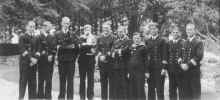 U-35 and U-42 crewmembers assembled at a POW camp.
Left to right:
Gerhard Stamer (U-35), Heinz Erchen (U-35), Hans-Joachim Roters (U-35),
Albert Schrader (U-35), Werner Lott
(U-35), Rolf Dau (U-42), Siegfried
Ludwig (U-42), Julius von Gosen (U-42), Otto Meye
(U-42), Max Dünnebier (U-42). [53]
U-35 and U-42 crewmembers assembled at a POW camp.
Left to right:
Gerhard Stamer (U-35), Heinz Erchen (U-35), Hans-Joachim Roters (U-35),
Albert Schrader (U-35), Werner Lott
(U-35), Rolf Dau (U-42), Siegfried
Ludwig (U-42), Julius von Gosen (U-42), Otto Meye
(U-42), Max Dünnebier (U-42). [53]
|
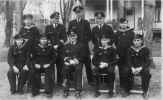 U-35 crewmembers assembled at the Grande-Ligne POW camp in Quebec, Canada, 1944.
U-35 crewmembers assembled at the Grande-Ligne POW camp in Quebec, Canada, 1944.
Back row, left to right: Gerhard Freier, Heinz Erchen, Hans-Joachim Roters, Gerhard Stamer, Paul Fichte Front row (seated), left to right: Albert Schrader, Siegfried Kienast, Werner Lott, Peter Schwarz, Kurt Grosser. [33] |
After returning to England in May 1946, Gerhard Stamer was a prisoner in the Sheffield, Llanover Park and Llan Martin POW camps. He began to correspond with Lord Mountbatten; from his reminiscences:
In summer 1946 we came back to England. The Captains and Chief Engineers of U-Boats were "frozen" and besides, as a result of my "screening" I was taken with "C" out of repatriation.
Then I thought of the former visit to The Tower and wrote to "The Viceroy of
India" with the request "You brought me in, please get me out".
Of course he couldn't but he was friendly enough to answer at once. I took this letter with me to the next interrogation, which lasted four hours and was not very pleasant as the interrogator, Lieutenant Edelstone had been severely treated in Germany. But his manner changed as soon as he read the letter and the "frozen in" melted.
 Georg Ludwig Hengen,
daughter Inge Hengen, and Gerhard Stamer in 1956. [60] Georg Ludwig Hengen,
daughter Inge Hengen, and Gerhard Stamer in 1956. [60]
|
 Gerhard Stamer in 1975 at his retirement.
Gerhard Stamer in 1975 at his retirement.
|
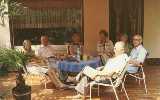 At the Stamer residence in 1978.
Clockwise from left: Erika Bruse, Siegfried Bruse, [not yet identified], Irma Stamer, Ingelore Bruse, Gerhard Stamer, Kurt Grosser. [20]
At the Stamer residence in 1978.
Clockwise from left: Erika Bruse, Siegfried Bruse, [not yet identified], Irma Stamer, Ingelore Bruse, Gerhard Stamer, Kurt Grosser. [20]
|
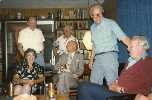 At the Bruse residence in 1979:
Seated, L-R: Irma Stamer, a fellow former POW, Hans-Joachim Roters.
Standing, L-R: A fellow former POW, Siegfried Bruse, Gerhard Stamer. [20]
At the Bruse residence in 1979:
Seated, L-R: Irma Stamer, a fellow former POW, Hans-Joachim Roters.
Standing, L-R: A fellow former POW, Siegfried Bruse, Gerhard Stamer. [20]
|
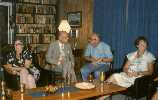 At the Bruse residence in 1979: Irma Stamer, a fellow former POW, Gerhard Stamer, [not yet identified]. [20]
At the Bruse residence in 1979: Irma Stamer, a fellow former POW, Gerhard Stamer, [not yet identified]. [20] On the wall hangs a painting of U-35, which was a present to Siegfried Bruse. |
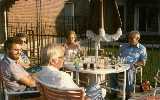 In Kitchener, Ontario, Canada in 1979:
Clockwise from front: Siegfried Bruse,
Wolf-Dieter Kempf, Irma Stamer, [not yet identified], Gerhard Stamer. [20]
In Kitchener, Ontario, Canada in 1979:
Clockwise from front: Siegfried Bruse,
Wolf-Dieter Kempf, Irma Stamer, [not yet identified], Gerhard Stamer. [20]
|
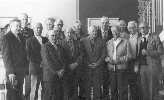 The 1980 reunion in Emden, Germany.
The 1980 reunion in Emden, Germany.L-R: Albert Schrader, Hans-Joachim "Jonny" Roters, Friedrich-Hermann Vollmer, Willi Jacob, Paul Liebau, Heinz Pfeifer, Martin Müller, Gustav Horstkötter, Wilhelm Janssen, Werner Lott, Karl Sommerer, Erich Bartold May, Peter von der Helm, Gerhard Stamer. [55] |
|
NACHRUF C 32 Am 19. August 1982 verstarb am Ende seines 70. Lebensjahres unser Crewkamerad Korvettenkapitän (Ing) aD Gerhard Stamer. Gero, wie ihn seine zahlreichen Freunde und die Crew nannte, gehörte, aus der Schulpforta-Erziehung kommend, zu unserer ersten Einstellung im April 1932. Infanterielehrgang, »Köln«-Auslandsreise und Marineschule erlebten wir in unbeschwertem Zueinanderwachsen. Im April 1936 zählte er, gerade zum Leutnant befördert, zu den ersten unserer Ings, die zur U-Bootwaffe kamen. Bei Kriegsbeginn war er LI bei Werner Lott auf U-35. - Bei den Orkneys ging das Boot am 29. November 1939 verloren. Der Chef des gegen U-35 ertolgreichen brit. Zerstörergeschwaders war kein geringerer als Lord Louis Mountbatten. Mit ihm kam es nach der Rettung der Besatzung zu einem kurzen, aber sehr fairen und menschlichen Kontakt. Und Lott und Stamer haben diesen Kontakt über Gefangenschaft und Heimkehr durch Jahrzehnte halten und pflegen können. Wie half er dann unserm unvergessenen Curt von Goßler die Kontakte zu den in alle Winde verwehten Crewkameraden zu knüpfen. Ewald Engler, sein Nachbar in den letzten Jahren und jahrzehntelang auch beruflich mit ihm verbunden, dürckte es, am Grabe für die Crew sprechend, so aus: »Es gab keinen Geburts- oder Jubiläumstag, den er vergessen hätte. Es gab kein Ereignis auch trauriger Art, an dem er nicht von Herzen Anteil genommen hätte. Es gab keine Notlage, die ihm bekannt wurde, in der er nicht geholfen hätte, auf unauffällige, aber nachdrückliche Art. Wie viel Kraft und Mühe und dabei ohne den eigenen Geldbeutel zu schonen, er dazu aufgewandt hat, ahnt zwar mancher von uns, genau weiß es aber nur seine liebe Frau, seine Tinke.« - Lott sprach uns aus dam Herzen: »Was nun? - Das Leben geht weiter und wir werden Gerhard Stamer in der guten Erinnerung behalten, die er verdient. Unsere ganze Zuneigung geht zu seiner tapferen lieben Witwe Irma, unserer Tinke, die diese lange schwere Zeit in einer großartigen Haltung durchgestanden hat. Wenn's etwas gibt, gewalt'ger als das Schicksal, dann ist's der Mut, der's unerschüttert trägt!« Wie wird Gero seiner Crew fehlen, nicht nur, wenn wir in der 2. Septemberwoche In Kiel unser 50jähriges Bestehen begehen! |
|
|
|
|
|
|
|
 (relative of
U-35 Chief Engineer Gerhard Stamer)
(relative of
U-35 Chief Engineer Gerhard Stamer)